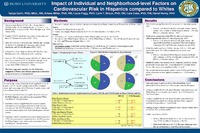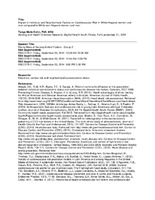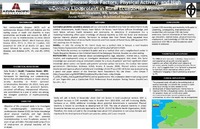| dc.contributor.author | Cohn, Tanya Marie | en |
| dc.date.accessioned | 2015-01-15T13:35:40Z | |
| dc.date.available | 2015-01-15T13:35:40Z | |
| dc.date.issued | 2015-01-15 | |
| dc.identifier | LEAD14PST93 | en |
| dc.identifier.uri | http://hdl.handle.net/10755/338330 | |
| dc.description | <p>Leadership Summit 2014 Theme: Personal. Professional. Global. Held at the Indianapolis Marriott Downtown, Indianapolis.</p> | en |
| dc.description.abstract | <p>Session presented on Friday, September 26, 2014:</p>
<p>Cardiovascular disease (CVD) is the leading cause of mortality for adults in the United States regardless of ethnicity. Yet, cardiac and noncardiac-related risk factors vary by ethnicity, as does mortality rate. Specifically, Hispanics in the United States have a higher prevalence of risk factors compared to non-Hispanic Whites, but lower overall cardiovascular-related mortality rate (Daviglus et al., 2012). This unexplained difference in risk versus mortality argues the need for the ability to accurately assess cardiovascular risk in order to provide appropriate treatment plans, medication, and behavioral interventions. This disparity suggest that other factors may be contribute to or protect against cardiovascular mortality. Therefore, a descriptive cross-sectional correlational design was used to describe, compare, and predict cardiovascular risk and mortality in White Hispanic women, White Hispanic men, White non-Hispanic women, and White non-Hispanic men. This included calculating the sex-specific 10-year General Cardiovascular Risk Score (FRS-10) and collecting individual-level factors (demographic characteristics; personal socioeconomic status [PSES]), individual-level non-FRS-10 cardiovascular disease risk factors (diastolic blood pressure, LDL, triglycerides, HbAlc, body mass index), and neighborhood-level factors (neighborhood socioeconomic status [NSES]; Hispanic ethnic concentration). Secondary data from an archival database from five adult hospitals within a Southeastern hospital system from 2012 - 2013 along with national data from the 2010 US Census and Floridacharts.org was used. A total of 3,317 individuals were included in this study with 1,523 being women and 1,794 being men. Approximately two-thirds of the sample was White Hispanics (77.5%) compared to White non-Hispanics (22.5%). FRS-10 risk was statistically significantly different across the four subgroups (p < .001) with White Hispanic women having less cardiac risk compared to White Hispanic men (p < .001) and White non-Hispanic men (p < .001). White Hispanic women had statistically significantly higher total cholesterol compared to White non-Hispanic women (p=.013) and White non-Hispanic men (p=.031). White Hispanic women also had statistically significantly higher LDL compared to White non-Hispanic women (p=.007) and White non-Hispanic men (p=.005). Pearson correlations showed that percentage Hispanics in a neighborhood had a statistically significant positive relationship with FRS-10 for White Hispanic women (r=-.08; p=.010) and White Hispanic men (r=.07; p=.013) compared to White non-Hispanic women (r=.08; p=.148) and White non-Hispanic men (r=.08; p=.131). Statistically significant positive relationships were found for all four subgroups between percentage of Hispanics in neighborhood and CVD mortality at the p < .001 level. Median household income had a statistically significant negative relationship with CVD mortality for all four subgroups at the p < .001 level. Thus, in this study, it was found that regardless of whether individuals were White Hispanic or White non-Hispanic as percentage of Hispanics in a neighborhood increased so did cardiovascular morality. Furthermore, as median household income decreased cardiovascular disease mortality increased. Implications for practice and research include: (1)expanding cardiac assessment to include neighborhood level factors in order to prescribe preventative and interventional measures for individuals regardless of their estimated cardiovascular disease risk based on typical cardiovascular risk factors; (2) more in depth prospective research should be conducted to better evaluate Hispanic neighborhood concentration, acculturation, cardiovascular risk, and cardiovascular mortality; and (3) neighborhood level cardiovascular disease risk assessment and interventions should be conducted with the potential goal of reducing a community's risk in order to impact a larger majority of those at cardiovascular disease risk.</p> | en |
| dc.format | Text-based Document | en |
| dc.language.iso | en_US | en |
| dc.subject | Cardiac Risks | en |
| dc.subject | Neighborhood Socioeconomic Status | en |
| dc.subject | Hispanics | en |
| dc.title | Impact of individual and neighborhood factors on cardiovascular risk in white Hispanic women and men compared to white non-Hispanic women and wen | en_US |
| dc.type | Poster | en |
| dc.rights.holder | <p>
All rights reserved by the author(s) and/or publisher(s) listed in this item record unless relinquished in whole or part by a rights notation or a Creative Commons License present in this item record.
</p><p>
All permission requests should be directed accordingly and not to the Sigma Repository.
</p><p>
All submitting authors or publishers have affirmed that when using material in their work where they do not own copyright, they have obtained permission of the copyright holder prior to submission and the rights holder has been acknowledged as necessary.
</p> | en |
| dc.description.note | <p>Items submitted to a conference/event were evaluated/peer-reviewed at the time of abstract submission to the event. No other peer-review was provided prior to submission to the Henderson Repository.</p> | en |
| dc.type.category | Full-text | en |
| dc.evidence.level | N/A | en |
| dc.research.approach | N/A | en |
| dc.contributor.department | Gamma Phi | en |
| dc.author.details | Tanya Marie Cohn, MSN, MEd., RN | en |
| dc.conference.name | Leadership Summit 2014 | en |
| dc.conference.host | Sigma Theta Tau International | en |
| dc.conference.location | Indianapolis, Indiana, USA | en |
| dc.date.conferenceyear | 2014 | |
| dc.contributor.affiliation | Baptist Health South Florida, Fort Lauderdale, Florida, USA | en |
| dc.description.reviewtype | Abstract Review Only: Reviewed by Event Host | en |
| dc.description.acquisition | Proxy-submission | en |






